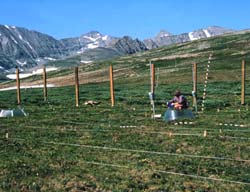Microbes active in Colorado snows fuel tundra ecosystem

"Microbial-level investigations are integral to developing an overall understanding of the alpine ecology at Niwot Ridge LTER site in the Colorado front range." <br>Photo by Timothy Seastedt, Niwot LTER <br>
Populations of fungi blanketed by Colorado’s snows are more active and diverse than previously thought, and are likely responsible for the productivity of the tundra ecosystem they are a part of, according to findings by scientists funded through the National Science Foundation (NSF)’s Long-Term Ecological Research (LTER) and Microbial Observatories programs. The researchers have published their results in this week’s issue of the journal Science.
Christopher Schadt, now of the Department of Energy’s Oak Ridge National Laboratory in Tennessee and a former graduate student at the University of Colorado at Boulder, said “the discovery should help scientists gain greater insight into decomposition rates, carbon cycles and the roles of individual fungi in those processes.” Surprisingly, the number of active microorganisms in tundra soils, for at least the top 10 centimeters, (about four inches) peaks when the soils are covered with snow. Schadt and colleagues performed their research at the Niwot Ridge, Colo., LTER site. Niwot Ridge is located some 12,000 feet atop the Rocky Mountains.
“The finding that microorganisms are interacting with tundra soils to a great extent highlights the important role of the snowpack in creating a unique and crucial environment in tundra ecosystems in Colorado and likely in other locations that are covered with snow for long periods of time in winter,” said Henry Gholz, LTER program director at NSF.
Metabolism of snow-covered microbes is an important biogeochemical “sink,” or way of storing, nitrogen. “The subsequent release in spring of nitrogen from the microbes’ metabolism is a major contributor to the relatively high productivity during the short growing season in the tundra,” said Steven Schmidt of the University of Colorado at Boulder, a co-author of the Science paper, and leader of the research team.
Schadt, Schmidt, and colleagues Andrew Martin of the University of Colorado and David Lipson of San Diego State University also found that fungi account for most of the biomass of the tundra, which undergoes significant seasonal changes. The researchers discovered that about 40 percent of the fungi in their samples were previously unknown. DNA sequencing enabled them to identify fungi that may hold answers to other questions about the tundra ecology in Colorado and in other locations around the world.
Media Contact
More Information:
http://www.nsf.govAll latest news from the category: Ecology, The Environment and Conservation
This complex theme deals primarily with interactions between organisms and the environmental factors that impact them, but to a greater extent between individual inanimate environmental factors.
innovations-report offers informative reports and articles on topics such as climate protection, landscape conservation, ecological systems, wildlife and nature parks and ecosystem efficiency and balance.
Newest articles

Trotting robots reveal emergence of animal gait transitions
A four-legged robot trained with machine learning by EPFL researchers has learned to avoid falls by spontaneously switching between walking, trotting, and pronking – a milestone for roboticists as well…

Innovation promises to prevent power pole-top fires
Engineers in Australia have found a new way to make power-pole insulators resistant to fire and electrical sparking, promising to prevent dangerous pole-top fires and reduce blackouts. Pole-top fires pose…

Possible alternative to antibiotics produced by bacteria
Antibacterial substance from staphylococci discovered with new mechanism of action against natural competitors. Many bacteria produce substances to gain an advantage over competitors in their highly competitive natural environment. Researchers…





















